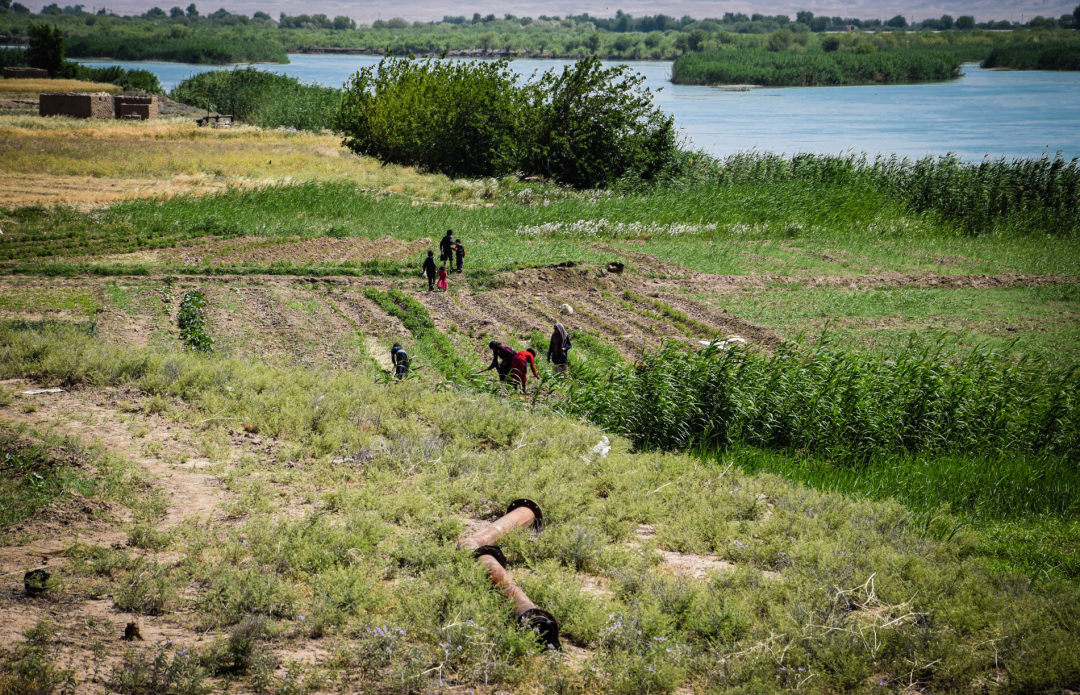Disclaimer:
Please be aware that the content herein has not been peer reviewed. It consists of personal reflections, insights, and learnings of the contributor(s). It may not be exhaustive, nor does it aim to be authoritative knowledge.
Title
Please provide a name for your action learning plan.
Mapping the effect of decreased water levels in the Euphrates River
Challenge statement
Challenge type: If you are working on multiple challenges, please indicate if this is your "big bet" or "exploratory" challenge.
Please note: we ask you to only submit a maximum of 3 challenges - 1x Big Bet, 2x Exploratory. Each challenge must be submitted individually.
BIG BET
Challenge statement: What is your challenge? (Please answer in specific terms: "Our challenge is that...”.)
Our challenge is the lack of updated qualitative, quantitative data and research, as well as insufficient international attention on the significant role of the Euphrates River in the region.
Background: What is the history of your challenge? What is causing or driving it? Who is involved? How does the current situation look like? What undesired effects does it produce?
Euphrates river plays a significant and strategic role in not only Syria but the middle east, as it is the largest surfaced water resource in southwest Asia. The Euphrates River, which originate in Turkey and flows in Syria and Iraq and joins its twin river Tigris in the Shatt al-Arab, has an estimated population of about 23 million around its basin, of which 44% lives in Iraq, 25% in Syria, and 31% in Turkey.
More than 70 per cent of water in the basin is used for agricultural production. In addition to being vital to agriculture and the livelihood of surrounding communities’ the river is an important source for drinking water and energy (hydropower) and is an important habitat for a large variety of animals and plants. In recent years, the river witnessed a drastic decline in water levels and extreme waves of droughts and floods. The occurrence of such extreme events and reduced river flows are a result of environmental degradation and climate change aggravated by:
• The upstream development plans and lack of transboundary cooperation.
• Ongoing conflict in Syria since 2011
• Overuse and exhaustion of natural resources
• Lack of sustainable water management and wastewater management mechanisms
• Pollution and exposure to nature and man- made contaminations.
As a result, the whole Euphrates ecosystem, which provides the base for biological diversity, economic productivity (the 2021 water crisis along the Euphrates River has threatened the livelihoods of approximately 5 million people), food security, water security, energy, human health, displacement and migration rates, and cultural resources are irreversibly affected.
Although there are many data driven studies and research on the Euphrates River challenges, these studies are not regularly updated and they are mostly scattered efforts that focus on one side of the challenge, e.g., on transboundary water governance, or impact on economic activities, thus failing to capture its complexity.
Quantitative evidence: What (official) data sources do you have on this challenge that better exemplifies the importance and urgency of this frontier challenge? You can add text, a link, or a picture.
http://waterinventory.org/surface_water/euphrates-river-basin
Qualitative evidence: What weak signals have you recently spotted that characterizes its urgency? Please provide qualitative information that better exemplifies the importance and urgency of this frontier challenge. You can add text, a link, or a picture.
• Water scarcity is a pressing issue that demands immediate attention, both locally and globally.
• Euphrates basin is home to an estimated population of about 23 million, of which 44% lives in Iraq, 25% in Syria, and 31% in Turkey.
• The misinformation about the Euphrates River needs to be addressed to ensure proper management and allocation of water resources.
• The declining status of biodiversity is a critical concern that must be addressed and brought to international attention to safeguard the river's basin ecosystem.
• There is a growing conflict over water resources is a serious issue that needs to be resolved
• Water mismanagement is exacerbating the problem of water scarcity and needs to be addressed through sustainable practices and better policies.
Value proposition: What added value or unique value proposition is your Accelerator Lab bringing to solving this challenge? Why is it your Lab that needs to work on this challenge and not other actors within UNDP, other stakeholders in the country respectively? Why is it worth investing resources to this challenge?
To advance UNDP Syria’s efforts in improving the generation and application of updated data and knowledge as well as strengthening advocacy and coordination related to climate change in general and to Euphrates River in particular; UNDP Accelerator lab Syria will work with water science policy to design and build an interactive platform capturing the journey of the Euphrates River from source to mouth, with a focus on the part running through Syria. The platform should be designed as an open-source, data-driven, and story-driven platform. The objectives of the platform are to a) Advocate, raise awareness, and educate the general public and decision-makers about the important Euphrates River as an ecosystem and the role it play in the region and how declining water levels is affecting communities that live in the river basin and which survival is dependent on the river ecosystem. b) Create an inclusive participatory space to engage UNDP national and international partners, including local communities, INGOs, CSOs, the government, and other key stakeholders, where they discuss and showcase challenges and solutions. c) Develop an open-sourced platform powered by research, data (qualitative and quantitative), and community stories to better inform future humanitarian & sustainable development projects, policies and decisions related to Euphrates River.
Short “tweet” summary: We would like to tweet what you are working on, can you summarize your challenge in a maximum of 280 characters?
Join us in exploring the journey of the Euphrates River in Syria! Our interactive platform raises awareness, engages stakeholders, and informs for the future of this crucial ecosystem. #EuphratesRiver #ClimateChange #SustainableDevelopment @UNDP Syria
Partners
Who are your top 5 partners for this challenge? Please submit from MOST to LEAST important and state Name, Sector and a brief description of the (intended) collaboration.
Please state the name of the Parter:
Water Science policy
What sector does our partner belong to?
Civil Society
Please provide a brief description of the collaboration.
WSP will support accelerator ab in building the interactive map of the Euphrates river and in data collection as well as in designing collective intelligence and sense-making workshops to engage wall-relevant communities and stakeholders.
Is this a new and unusual partner for UNDP?
Yes
Learning questions
Learning question: What is your learning question for this challenge? What do you need to know or understand to work on your challenge statement?
How can we enhance awareness, data , and the knowledge around the Euphrates river to inform the public and draw the necessary national and international attention it needs?
To what stage(s) in the learning cycle does your learning question relate?
Sense, Explore, Grow
Usage of methods: Relating to your choice above, how will you use your methods & tools for this learning question? What value do these add in answering your learning question?
Each of these methods will provide valuable support throughout different stages of the project. System thinking will assist in mapping the basin's ecological system and identifying how the complex challenges associated with the Euphrates River are interconnected. Solutions mapping will allow us to map grassroots solutions, coping mechanisms, and positive developments in the region to overcome challenges resulting from scarcity or declining water levels in the river. Sensemaking will help us define our challenges and determine what UNDP can do about them with different partners and stakeholders. Human-centered design will enable us to design a platform that prioritizes the needs of people and provides easily accessible knowledge products.
Existing data gaps: Relating to your choice above, what existing gaps in data or information do these new sources of data addressing? What value do these add in answering your learning question?
There is a significant lack of reliable data surrounding the Euphrates river, which has resulted in a considerable amount of misinformation and knowledge gaps. In order to comprehensively grasp the complexity of the challenges faced by the region, we intend to leverage a range of diverse data sources. Our aim is to gain insights into the behaviors and cultures of the affected communities, assess the impact of water scarcity on biodiversity, human activity, and communities, and to inform future UNDP projects. It is crucial to curate and visualize the collected data in a centralized location to enable easy access and efficient knowledge management.
Closing
Early leads to grow: Think about the possible grow phase for this challenge - who might benefit from your work on this challenge or who might be the champions in your country that you should inform or collaborate with early on to help you grow this challenge?
The platform that will result from this challenge will not only be beneficial to UNDP, but it will also serve as a comprehensive knowledge source on the Euphrates river for researchers, the public, and academia. Users will be able to access up-to-date data and knowledge on the river through the platform. Furthermore, the platform will be valuable to governments, civil society, and other international organizations such as UN agencies.
END OF ACTION LEARNING PLAN: Thank you! The form saves automatically and your submission has been recorded. You may now exit this window.


 6Clean water and sanitation
6Clean water and sanitation 14Life below water
14Life below water 15Life on land
15Life on land
Comments
Log in to add a comment or reply.